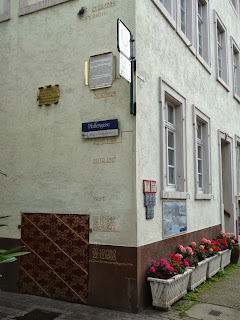In August, the weather in Heidelberg is quite pleasant with the temperature hovering around 20 degrees Celsius in the daytime. But we realised it can still be hot enough if you have to go for a walk. We took plenty of water the day we decided to walk the Philosopher's Way trail.
Apparently, professors and philosophers from the university nearby used to walk here often, drawing inspiration from the solitude and splendid views of the town.
We walked up a gradual slope and reached a small but colourful garden that offers panoramic views of the Old Town. There are plenty of sites to see along the way - old building, vineyards, flora, some fauna, maybe some large lizards.
The small garden is a good place to catch you breath and take in the scenic beauty the place has to offer. Also in the garden is a memorial stone to Joseph von Eichendorff, a romantic poet who studied in Heidelberg in 1807.
The trail continues for about 3 kms, but we took the exit via the Snake Path (so called because of the narrow, winding lane that leads to the river).
There are also some 'Insect Hotels' you will see here and other places around town. It is basically a small stand made of untreated wood with many drilled holes for insects to hibernate and breed. This is especially helpful since many natural forests here are heavily guarded against pests and diseases, leaving the insect population especially bees and wasps, out in the cold.
Later in the evening, we had booked a short cruise on the river, and since the 400th anniversary celebrations were on full swing, there would also be a fireworks display at the end of the tour. We boarded the cruise boat and got a front seat. If you don't want to be stuck inside the cabin with limited views, get there early and bring a warm jacket. It wasn't cold to begin with but it got pretty chilly by the time we got off.
The cruise offers stunning scenic views of forests and homes surrounded by nature. It was an hour long gentle cruise, and by the time we got back it was starting to get dark. Normally you'd alight the boat, but we were there at the front lines for the fireworks as well. Those lucky enough to have homes on the riverfront were out in their balconies, and the rest were lined up along the river with their picnic baskets and beer.
There was another fireworks display the next day as well, but we were in the car on the bridge. We saw some of the cars slowing down so we pulled over for a while as well. With that, the weekend celebrations ended, but there was still plenty more to do.
Apparently, professors and philosophers from the university nearby used to walk here often, drawing inspiration from the solitude and splendid views of the town.
We walked up a gradual slope and reached a small but colourful garden that offers panoramic views of the Old Town. There are plenty of sites to see along the way - old building, vineyards, flora, some fauna, maybe some large lizards.
The small garden is a good place to catch you breath and take in the scenic beauty the place has to offer. Also in the garden is a memorial stone to Joseph von Eichendorff, a romantic poet who studied in Heidelberg in 1807.
The trail continues for about 3 kms, but we took the exit via the Snake Path (so called because of the narrow, winding lane that leads to the river).
There are also some 'Insect Hotels' you will see here and other places around town. It is basically a small stand made of untreated wood with many drilled holes for insects to hibernate and breed. This is especially helpful since many natural forests here are heavily guarded against pests and diseases, leaving the insect population especially bees and wasps, out in the cold.
Later in the evening, we had booked a short cruise on the river, and since the 400th anniversary celebrations were on full swing, there would also be a fireworks display at the end of the tour. We boarded the cruise boat and got a front seat. If you don't want to be stuck inside the cabin with limited views, get there early and bring a warm jacket. It wasn't cold to begin with but it got pretty chilly by the time we got off.
The cruise offers stunning scenic views of forests and homes surrounded by nature. It was an hour long gentle cruise, and by the time we got back it was starting to get dark. Normally you'd alight the boat, but we were there at the front lines for the fireworks as well. Those lucky enough to have homes on the riverfront were out in their balconies, and the rest were lined up along the river with their picnic baskets and beer.
There was another fireworks display the next day as well, but we were in the car on the bridge. We saw some of the cars slowing down so we pulled over for a while as well. With that, the weekend celebrations ended, but there was still plenty more to do.




































